Best of India Tours
- Golden Triangle Tour- Best of India & Nepal
- Classical Rajasthan
India Cultural Tours
- Images of North India- Karnataka Heritage
- Rajasthan & Goa Tour
Discover India Tours
- Grand India Tour- North to South India
- Central to South India
Rajasthan Tours
- Classical Rajasthan Tour- Golden Triangle Tour
- Grand Mughal Tour
India Luxury Trains
- Palace on Wheels- The Golden Chariot
- India Deccan Odyssey
- The Indian Maharaja
- Royal Rajasthan on Wheels
Nepal Tours
- Glimpses of Nepal- Buddhist Pilgrimage
- Nepal River Rafting
- Destinations of Nepal
- Nepal General Info
India Wildlife Tours
- North India Wild Life- South India Wildlife
Tibet Tours
- Tibet Monastery Tours- Explore Tibet
- Destinations of Tibet
Spa & Yoga Tours
- Ananda in Himalayas- Yoga & Meditation
Adventure Tours
- Manali Safari Tour- Himalayan Trekking
- Horse Safari
Mahabalipuram
Chennai
![]() Chidambram
Chidambram
![]() Coimbatore
Coimbatore
![]() Kodaikanal
Kodaikanal
![]() Madurai
Madurai
![]() Mahabalipuram
Mahabalipuram
![]() Ooty
Ooty
![]() Pondicherry
Pondicherry
![]() Tanjore
Tanjore
![]() Trichy
Trichy
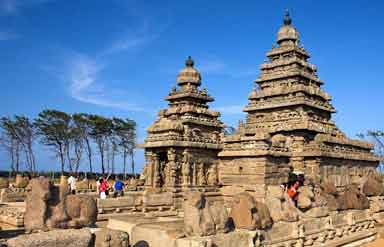
A soft pearly light dims the stars and lifts the opaque veil of darkness from Mahabalipuram and the pyramidal contours of a diminutive temple swim into view silhouetted against a vast cathedral sky, like a wondrous unreality spun out of early morning magic. The colours deepen; the virginal blush of dawn smears the sky. Delicate skeins of pale gold and searing orange lie intertwined in intimate embrace across the smudged horizon, suffusing the idle waters of the Bay of Bengal—an unabashed foreplay of colours. A thin hot wedge of vivid red emerges out of the sea, growing every moment into mahabalipuram a flaming, pulsating disc that soon disowns the theatre of its birth
The lone temple, that guardian of the shore, is a becalmed spectator. It has been an apathetic witness to this impassioned spectacle every dawn for the last 1,200 years.Mahabalipuram (or Mamallapuram, its ancient name) is one of history’s intriguing enigmas. Situated just 60 km off Chennai on the Bay of Bengal coast in the South Indian state of Tamil Nadu, Mahabalipuram was a flourishing port town of the Pallava rulers of South India who chiselled in stone a fabulous open-air museum of sculptures under the vault of a burning sky. That much is known. But was this sculptural glorification a king’s fancy? A celebration of war victories? A queen’s fantasy? No one actually has any answer. The mystery of Mahabalipuram lingers, unravelled, but its sculptural extravaganza is a living testament of the virile artistic temperament of the Pallavas who were trendsetters in South Indian art.
Sightseeing
Mahabalipuram with its picturesque location on a rocky outcrop between the beach and a lagoon is a happy combination of history, good beaches, hassle-free tourism and fabulous fish and lobster! Despite the many visitors, drawn by the former Pallava dynasty town, the place is friendly, relaxed, and the villagers are remarkably unperturbed by their crowds of visitors. Mahabalipuram is renowned for its series of charming rathas and the spectacular carved relief depicting Arjuna’s Penance. The magnificent Shore Temple, built by king Rajasimha in the seventh century, is a unique temple that houses the shrines of both Shiva and Vishnu while the Varaha Cave is a rock-cut mandapam with two incarnations of Vishnu—Varaha and Vamana—besides scenes of kings and queens. The Krishna Mandapam has a bas-relief of Lord Krishna lifting the Govardhan hill in his fingertips. Other important attractions of Mahabalipuram include the Mahishasuramardini Cave, Kotikal Mandapam, Ramanuja Mandapam, and the Dharmaraja Cave.
Excursions
Mahabalipuram is a part of the Golden Triangle circuit of South India along with Chennai and Kanchipuram. As such, it is generally visited in combination with these two places. Kanchipuram (65 km) is the synonym for some of India’s finest silk saris. This dusty, small town, popularly called the Golden Town of a Thousand Temples, is renowned for the Kamakshi, Varadarajaswami, and Kailasanathar temples, all more than worthy of a visit. And about the Kanchi weavers, any ode would fall short! Vedanthangal is the site of a bird sanctuary, one of India’s largest, while Covelong is famous for its golden beach and other historical monuments.
Excursions for Mahabalipuram
Arjuna's Pennace
Arjuna’s Penance, an enormous relief made on two huge boulders, is the universe itself in stone, throbbing with a vastness of conception. This colossus of art, 27 metres long and 9 metres high, is perhaps the world’s largest bas-relief. The cleft in the rock depicts the descent of the Ganga, brought to earth by King Bhagiratha to redeem the cursed souls of his ancestors. The two large elephants are remarkable for their artistry, and so are the scenes from the Panchatantra. There is a forest with tribal people and all forms of animal life, just as they would appear in their habitat. Women are clothed in an aura of ineffable grace, a rich inner beauty transfiguring the plainest of them. The whole scene has a delicate edge of humour. Juxtaposed against the ascetic is a cat doing rigorous penance too, eyes firmly shut, even to the delectable mice scampering around within easy reach.
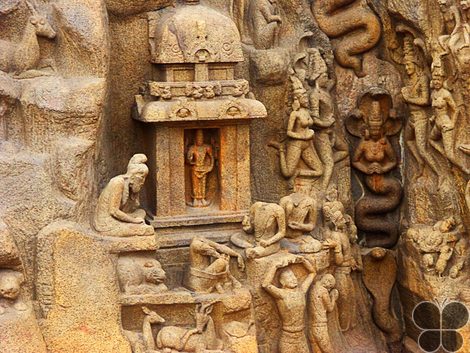
Caves Mahabalipuram
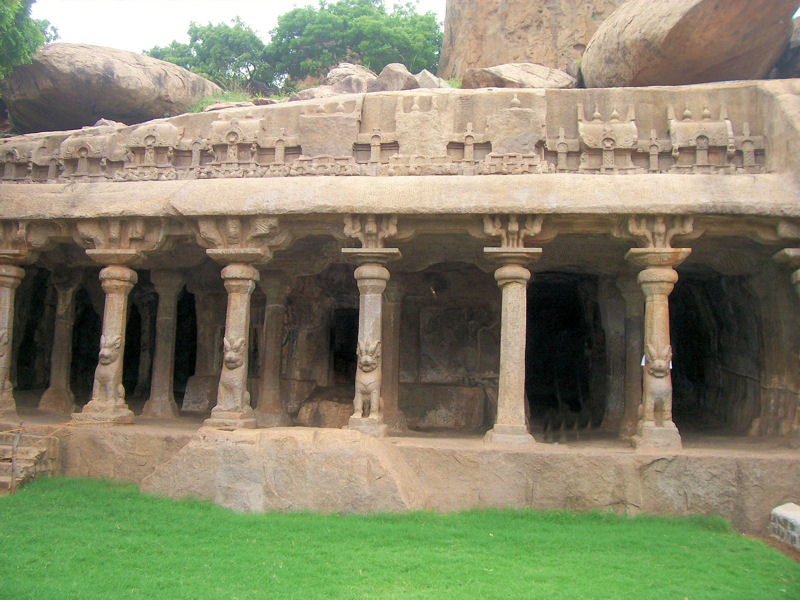
he Varaha Cave, a small rock-cut mandapam (hall), is a faceted and finished gem with two incarnations of Vishnu—Varaha (boar) and Vamana (dwarf). Particularly noteworthy here are four panels of the famous Pallava doorkeepers. There is about them a mood of contemplative reverie, a lyrical softness and subtle grace totally at variance with the primordial machismo their role as guards of the gods imposes on them. The Dharmaraja Cave, built in the early seventh century, contains three empty shrines. The Mahisasurmardini Cave (mid-seventh century) has fine bas-reliefs on its panels of enduring beauty. The Somaskanda sculpture radiates peace, power, and wisdom while Lord Vishnu is shown in omniscient repose in a masterpiece of dhwani (the art of suggestion).
On the opposite side is a huge theatrical panel showing, Goddess Durga\’s fight with the demon Mahishasura, an episode culled from the celebrated Sanskrit poem Devi Mahatmya. About 5 km north of Mahabalipuram is another cave called Tiger Cave, a rock-cut shrine possibly dating back to 7th century.
Rathas
A group of structures lying at the southern extreme of Mahabalipuram, amidst casuarina trees, are the famous Rathas (chariots). The Pancha Pandava Rathas, as they are called, are five in number. Out of these, four are carved out of a single rock, while the fifth on the west is scooped out from a small rock. The square Draupadi and Arjuna Rathas, the linear Bhima Ratha, the taller Dharamraja Ratha and the apsidal Nakula-Sahadeva Ratha, constitute the complex. Besides these, there are the Ganesha Ratha to the north of the main hill and two Pidari Rathas on the eastern side. The hut-like Draupadi Ratha sports doorkeepers and Durga with a worshipper offering his head.
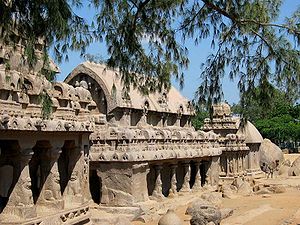
The Arjuna Ratha, facing west, has its outer walls carved with the most graceful figures of gods and mortals. The Sahadeva Ratha with a huge monolithic elephant in front; the Bhima Ratha with its two storeys and lion-based pillars; and, of course, the Dharamraja Ratha—the biggest and finest of them all with its eight panels of exquisite sculptures—provide the visitor with insight into the craftsmen\’s skill of a time long gone by.
Krishna Mandapam
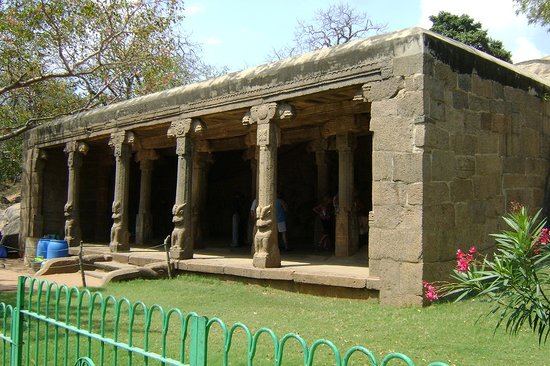
The Krishna Temple is one of the earliest rock-cut temples of Mahabalipuram. The walls of the temples depict scenes of pastoral life, one with the image of Krishna lifting the Govardhan Hill in his fingertips to protect his people from Indra.
Shore Temple
The windswept and surf-beaten Shore Temple, the mute tireless sentinel of the shore, is the ultimate expression of Mahabalipuram. A three-in-one abode of God—a Vishnu temple sandwiched between two Shiva temples—it is a visual delight, its precincts abounding in architectural masterpieces. On either side of it the sea spreads, illimitable and infinite. The compound wall of this temple is lined with charming sculptures of Nandi the bull while the figure of Vishnu is present in the sanctum sanctorum. The Shore Temple forms the backdrop of the Mahabalipuram Dance Festival celebrated in the month of January/February every year. This festival is an occasion when artists from all over the country come together to perform.
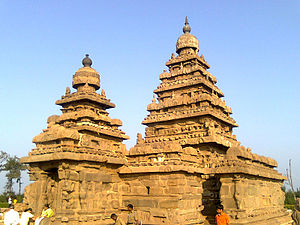
Covelong
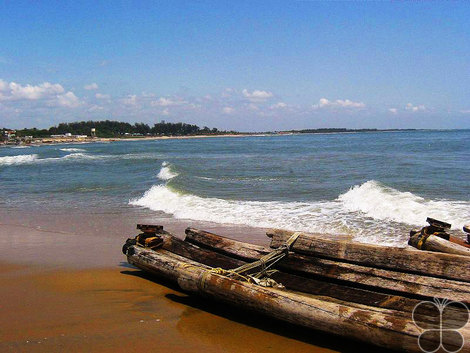
Just 19 kilometres from Mahabalipuram is situated the picturesque beach resort of Covelong, a quiet fishing village with the remains of a fort. Facilities for windsurfing, swimming and water sports are available here. If you are in Mahabalipuram, don’t miss out on a visit to this place.
Crocodile Bank
The Crocodile bank is situated barely 14 km from Mahabalipuram on the Chennai-Mahabalipuram road. Set up by an American named Romulus Whitaker in 1976, the number of crocodiles in the bank grew in its first 15 years from just 15 to over 5,000. Located nearby is a snake farm where anti-venom is produced for treating snakebites.
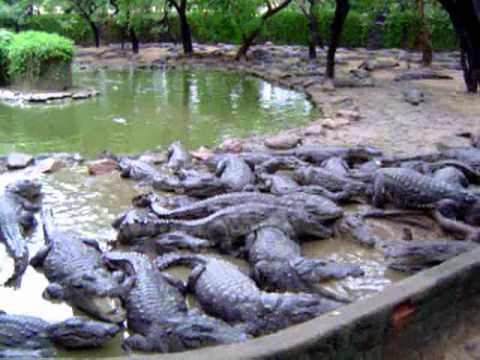
Kanchipuram
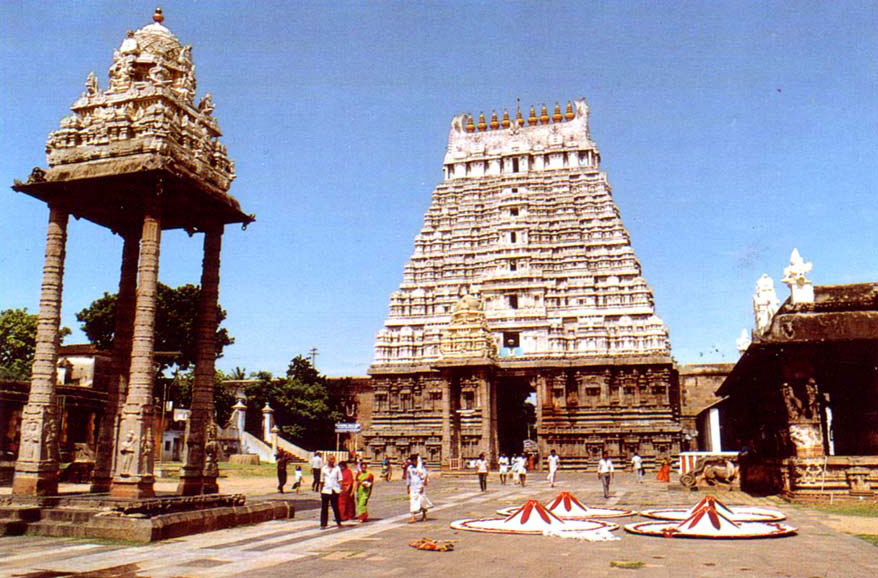
A 65-kilometre stretch of sun-scorched road connects Mahabalipuram to the fabled city of a thousand temples, Kanchipuram. There are 650 stone inscriptions in Kanchipuram belonging to different dynasties. The temples here reflect the maturity and efflorescence of Pallava art and the ornate and often imposing embellishments were produced later by the Chola, Vijayanagara and Chalukyan kings. There is a solemn grandeur, a grandiosity of vision and ornamental excess in the temples here. A disembodied otherworldly stillness impregnates their vast inner domainswhere time is a captive fugitive. The Ekambaranathar temple, the Kailasanatha temple, Sri Varadaraja temple, Sri Vaikuntaperumal temple… the names stretch endlessly.
The city itself is dedicated to the presiding deity, Sri Kamakshi (one with eyes of love) at the Kamakshi temple. In Sanskrit, the word Kanchi denotes girdle, and poets have allegorically characterized the city as a girdle to the earth. And so it was. A seat of learning that attracted scholars from far-flung corners of the globe. But what has now girdled the earth is the gold-embroidered Kanchipuram silk sari that has been for centuries a prized possession of the South Indian woman. Shops dealing with silk and cotton saris and material line the main street of the town and for a demonstration of the skills of the Kanchi weavers, visit the Weaver’s Service Centre on Railway Station Road
Kanchipuram is the only city in South India to have played such a dominant, decisive and continuous role in the history of the peninsula. At one time, it was the hub of the empire, of pomp and panoply. Today, it is a small place that time has forgotten. Royalty abandoned it long ago and history shifted its allegiance to other more dramatic arenas. And in the quiet interregnum of the centuries when life thundered by elsewhere, the ancient city, wrapped in nostalgia, too proud to change with the times, withdrew from the mainstream. To become what it is today. An Arcadian fastness of beauty. A dreamy detachment and a quaint medievalism, the lasting impression of which one consigns to memory.
Muttukadu
An ideal place for water sports, Muttukadu is 21 km from Mahabalipuram. The Tamil Nadu Tourism Development Corporation (TTDC) has a boathouse here. Visitors can enjoy boating, canoeing, kayaking, and windsurfing. The Dakshina Chitra of Madras Craft Foundation here has replica of an old agricultural house of Tamil Nadu, replica of Kanchipuram weavers house and replicas of ancient houses presenting the lifestyle of South India.
Vedanthangal
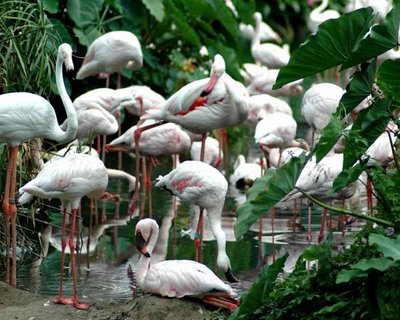
Located 53 km from Mahabalipuram, Vedanthangal is one of the oldest bird sanctuaries in India. The sheer number of birds that visit this sanctuary is amazing. It is said that almost 1,00,000 avian species of varied shapes, sizes and hues—including storks, egrets, cormorants, darter, and flamingos—visit this sanctuary between October and March.
Fact File
 Area: 8 sq. km
Area: 8 sq. km
 Population:13,300 (1991)
Population:13,300 (1991)
 Altitude:Sea level
Altitude:Sea level
 Best Time to Visit:October to March
Best Time to Visit:October to March
 Languages:Tamil and English
Languages:Tamil and English
 STD Code: 04114
STD Code: 04114
Click below for Tours of Madurai, Tamilnadu & Kerala Tours
-
South India Panorama
Chennai – Kanchipuram – Mahabalipuram - Trichy – Tanjore – Madurai – Rameshwaram - Periyar - Kumarakom - Kovalam - Kanyakumari – Trivandrum – Cochin – Munnar – Coimbatore – Ooty – Mysore – Hassan – Bangalore – Hampi – Badami – Goa - Bombay (Duration )
 Duration:(30 Days)
Duration:(30 Days) -
Explore South India Tour
Chennai - Mahabalipuram - Pondicherry - Trichy - Madurai - Trivandrum - Allapuzha - Cochin - Coimbatore - Ooty - Mysore - Hassan - Bangalore - Goa - Mumbai
 Duration:(21 Days)
Duration:(21 Days) -
Temples & Back Waters of South India
Mumbai - Madurai - Periyar - Kumarakom - Cochin - Mysore - Hassan - Bangalore - Mumbai
 Duration:(13 Days)
Duration:(13 Days)




